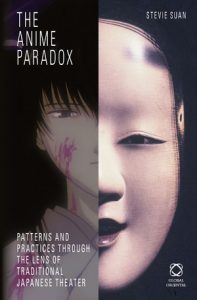
Winner of the 2023 Japan Society for Animation Studies Award
A formal approach to anime rethinks globalization and transnationality under neoliberalism
Anime has become synonymous with Japanese culture, but its global reach raises a perplexing question—what happens when anime is produced outside of Japan? Who actually makes anime, and how can this help us rethink notions of cultural production? In Anime’s Identity, Stevie Suan examines how anime’s recognizable media-form—no matter where it is produced—reflects the problematics of globalization. The result is an incisive look at not only anime but also the tensions of transnationality.
Far from valorizing the individualistic “originality” so often touted in national creative industries, anime reveals an alternate type of creativity based in repetition and variation. In exploring this alternative creativity and its accompanying aesthetics, Suan examines anime from fresh angles, including considerations of how anime operates like a brand of media, the intricacies of anime production occurring across national borders, inquiries into the selfhood involved in anime’s character acting, and analyses of various anime works that present differing modes of transnationality.
Anime’s Identity deftly merges theories from media studies and performance studies, introducing innovative formal concepts that connect anime to questions of dislocation on a global scale, creating a transformative new lens for analyzing popular media.
Praise for Anime’s Identity:
“Stevie Suan utterly transforms our understanding of anime. Using media theory to expand the formal analysis of anime conventions, while calling on a transnational framework to avoid a simplistic opposition between local and global, he not only provides incisive readings of key anime series, but also lays out a powerful and much-needed methodology for thinking anime in the world.”
—Thomas Lamarre, author of The Anime Ecology: A Genealogy of Television, Animation, and Game Media
“Focusing on formalism and performance studies in particular, Stevie Suan proposes a radical alternative for engaging with anime studies.”
—Daisuke Miyao, author of Japonisme and the Birth of Cinema
“[Anime’s Identity] is also a readable and concise digest of much of the theory and research on anime in the last decade, serving as a valuable primer for the new scholar….Suan gets to grip with an issue that has hounded people who write about anime for decades – to what extent can we get away with an essentialist notion that it ‘comes from Japan’?
—Jonathan Clements, author of Anime: A History.
“Anime’s Identity provides a multilayered overview of cultural debates on anime for an English-reading audience….As a theoretical treatise, the book equips scholarly readers with a well-nuanced interdisciplinary approach to TV anime.”
—Ana Micaela Chua Manansala, The Journal of Asian Studies
“[Anime’s Identity is a] readable contribution to anime media theory that is both well-grounded and provocative. The text will be of great interest to anyone studying anime, animation in general, media, or global media circulation. This book is in conversation with other works of anime media theory, such as Thomas LaMarre’s The Anime Machine, but is an innovative addition to the field that will likely become required reading like its predecessors.”
—Christopher Smith, Delos: A Journal of Translation and World Literature
Titles of the chapters and subsections:
Introduction: Anime’s Performance of Identity
Anime’s Identity; Macross’s Identity; The Anime-esque; On Forms; Shifting Spatiality; Area Studies and Situating Anime; Media-Form; Historical Moment; Performance/Performativity; Overview of the Book
1. Anime’s Local–Global Tensions
The Bordered-Whole Inter-National; Mapping Anime’s Distribution; Anime’s Inter-national Stasis; Defining Anime; Anime as National Cultural Media-Form; AnimeJapan; Blurring Internal and External
2. Anime’s Dispersed Production
Authorship and Agency in Anime Production; On Anime Production and Publicity; Shirobako; Negotiated Decisions; Media Mix and Materiality; Anime’s Media-Form; Transnationality
3. Anime’s Media Heterotopia
Geographies of Production; Transnational Development; Anime’s Animation Production Network Across Asia; Heterotopic Images; (In)visible Performances; Transnational Hierarchies; Anime’s Media Heterotopia
4. Anime’s Citationality
Anime’s Brand; Felicitous Anime-esque Performance; Database, Citation, Re-performance; Re-performance, Convergence; Decentralized Network of Citations
5. Anime’s Creativity
Anime’s Creative Industry; Creativity and Copying; Citationality and Anime’s Creativity; Citations across Borders; Anime’s Creativity in China; Openly Transnational Anime; Anime across Asia
6. Anime’s Actors
Animation and How Objects Act; Embodied Performance; Figurative Performance; Mutual Implication; Lifestyle Performance and Figurative Acting
7. Anime’s (Anti)Individualism
From Evangelion to Sekaikei; Sekaikei and (Neoliberal) Individualism; Evangelion’s Success and Failure; Deconstructing Individualism; Global Anxieties; Micro-Macro, Local-Global Tensions; After Sekaikei
8. Anime’s Dislocation
Place-Focused Anime; Dislocation in Anime’s Performances; Theatricality; The Animatic Apparatus; Producing Places; Anime Out of Place; Dislocating Differently; Anime’s Complex Spatiality
Conclusion: Anime’s World
Anime’s Performance of Media-Form; Enacting Selfhood; Global Inflections; Shifting Transnationalities; Clashing Forms, Complex Regionality
